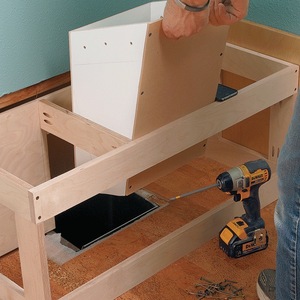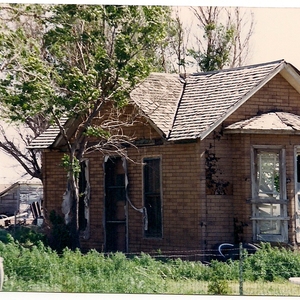Hi! I am installing the ClosetMaid Hang Track system into a section of our closet to give us more shelving space, but am doing it around our existing pre-installed wire shelving. We have all the components cut to the correct size and were set to go when I decided to give a quick sweep over the wall with the metal scanner. I am seeing a ton of metal supposedly in the walls, but cannot figure out what the metal could be. We are not installing next to laundry, bathrooms, etc. One wall is backed against a closet and the other is the outside of the house. No where in the ClosetMaid directions does it say I should worry about scanning for metal, but as a relatively novice DIYer, I don’t want to drill anywhere I would regret. Could this simply be the already installed wire shelving screws that are setting it off (though at times I am 4-5 inches from the shelves and the metal scanner is still beeping), or is it something I need to be aware of before preceeding?
Thanks for your help!
Discussion Forum
Discussion Forum
Up Next
Video Shorts
Featured Story

Fine Homebuilding is excited to be the official media partner of the 2024 Building Science Symposium series! This event offers builders, tradesmen, architects, designers and suppliers to discuss topics ranging…
Highlights
"I have learned so much thanks to the searchable articles on the FHB website. I can confidently say that I expect to be a life-long subscriber." - M.K.

















Replies
Well, it could be drywall nails holding the wallboard in place. It could be wiring or plumbing. It could be metal framing. It could be HVAC ductwork. It could be metal lath to support plaster.
All wiring and plumbing is SUPPOSED to be at least 1.5" behind the wall surface, so if you use fasteners no longer than that you're safe. But of course, things aren't always the way they're supposed to be.
What sort of "metal scanner" are you using?
Reply
Dan,
Thank you for your time. I am using the Zircon OneStep i320 set on metal. According to ClosetMaid, I will need to use 3'' combo screws with anchors for the drywall installation, as I will not be able to able to hit more than 1 stud.
also...........
how high are you hanging that trac?
how far from the ceiling?
K
How old is the house? Lath nails, drywall nails, dw screws?
Does the alarm repeat vertically or rampant locations.
Are you anchoring into studs for this track system?
Air return/supply, homerun wiring?
What are you using, metal detector or a stud finder set on a metal setting?
Reply
Hi Calvin,
Thanks for your help. The house if brand new - we moved in about 7 months ago.
I'm using the Zircon OneStep i320, a stud finder set on the metal setting. I've identified 2 vertical pipes running throughout, but the Zircon just beeps in probably 10+ other locations, including a large area I was planning on install the Shelf Track. Going much lower does not make it worth the installation.
I will hit 1 stud on each 40'' track, but will also need to use the 3" combo screws with wall toggles for the rest of the holes.
I just can't figure out if it's going off just for nails and/or because I am a few inches away from the wire shelving around installed on top and I should ignore it, or if I'm going to drill into something I will regret.
K
I'm not there and can only guess.
If it's ductwork-panning for air return (doubtful in an outside wall), then that might confuse the tracer.
If you have some rare earth magnets (regular won't work for shit), find drywall screws/nails-which are fastened to the studs-they'll stick good by just palming them in your hand and running that around the area.
Those in a straight line vertically would give you stud for sure.
40" long? one stud only? seems odd-except in maybe a 2' center spacing on the framing.
Hilti (or other) Togglers-you mark the spot-drill the hole and then insert a "butterfly" anchor-that gets "fastened to the board" by a plastic slide-.so you can put in the screw-remove-put it back in again-and none of those flopping butterflys to contend with when mounting the track.
http://www.us.hilti.com/holus/page/module/product/prca_rangedetail.jsf?&nodeId=-498434&selProdOid=465696
Come in 3/16" and 1/4x20. one might fit the track holes or bore new bigger ones.
Pull a baseboard?
Can you pull a baseboard and look under the drywall? Is there a basement below or attic above where you can see what is running into the wall?
How much weight are you intending to hang on the shelving? If you can't hit two studs, the only anchors I would consider are the spring loaded 'butterfly' anchors which open up behind the drywall. Forget those little plastic POS things. Use lots of anchors, over-engineering cures a lot of diy faults.
How wide is the shelving that you can't hit two studs? Are you taking the word of the scanner that there is only one stud? They can be misleading. Consider screwing boards horizontally to hit at least two studs and then anchor your shelving into the boards.
Good luck from a diy-er who has hung a whole lot of wire covered shelving.
One thing you can do is drill some small holes just barely through the drywall -- not deep enough to hit any pipes or wires -- and then feel around with a piece of wire.
It's always important to hit the stud and not glance off one side in case wires run up the side of the stud (wires on the side of a stud closer than 1-1/4" to the face of the stud are not required to have a nail plate, while those passing through it closer than 1-1/4" are).
Wires running horizontally are normally at belt height or there about since that's the most comfortable height to drill studs.
Personally I have yet to use a stud finder that works well enough to trust the warnings. Walls can have any number of wires and whatnot so nothing surprises me anymore. Some modern house designs require a large amount of hangers and metal straps to hold all the sheer walls and beams together. Most likely I'd guess there's wire in the walls - either romex, coax or cat 5. Since it's a closet there's also a chance someone had some metal studs and they are placed flat to the sheetrock for additional screw holding between studs - although only custom builders normally add any backing and it's normally 2x wide blocking, although some will use plywood flat to the sheetrock.
If you are really concerned about putting long screws into a stud, drill a 3/4" hole just next to your screw location to the side of the stud. It's big enough to look in and see if there is a wire or pipe passing directly through the stud where your screw will be. The hole will be covered by the track. If I'm concerned a pipe or wire I'll carefully poke a scratch awl next to the stud and feel around....wires or pipes are easy to feel if they are there. Same principle can also be used whenever driving big/long screws.....to make the least visible holes drill a small hole just large enough to pass a coat hanger wire through. Keep the visible hole small, but drill it a few times at angles up and down so the wire can rotate around. A hole this size is easily filled with caulking (wipe the surface with a damp cloth to eliminate caulking residue around the tiny hole.
Rather than toggles in sheetrock I preffer to carefully open up the sheetrock enough to insert a 2x4 or 2x6 and screw it to the studs with two 3" or 3-1/2" deck screws per side. Again, this is done in a way that it's covered by the track or cabinets. It only takes a 2" slot in the sheetrock to fit a 2x4 through and work into place and if the track is extra thin and it's visible i've only opened up a 1-1/2" slot just wide enough to slide the 2x4 straight in.